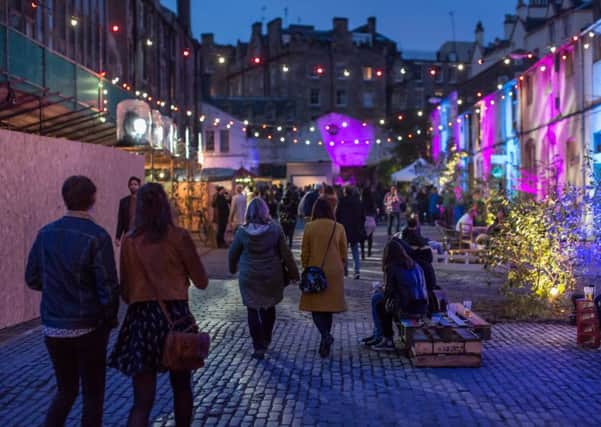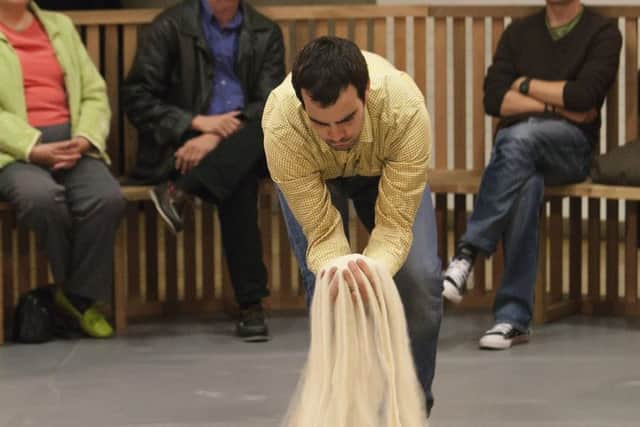Joyce McMillan: Exploring new space behind Hidden Door


When I arrive at a hidden courtyard off King’s Stables Road – just in the lee of Edinburgh Castle – David Martin is kneeling on the cobbles of the old stable-yard, wrestling with an oddly-shaped piece of wood. There are just four days to go before the opening of Hidden Door, the nine-day Edinburgh mini-festival of music, art, theatre, film and spoken word that Martin first launched two years ago in the Waverley arches at Market Street. Construction work is in full swing, as the Hidden Door team put together all the stages, installations, bars and lighting-rigs that need to be made, put in place, and given a touch of design magic before this courtyard can become the little wonderland of creative energy that attracted more than 10,000 visitors last year, and offers both a unique opportunity for young artists, and a memorable week of early summer fun for audiences.
“When I left Edinburgh College of Art in 2000,” says Martin, “all I knew was that I wasn’t going to do what so many of my college friends did, and head off to London or Glasgow or some other city that seemed to offer more opportunities for young artists. I grew up in Fife, I’ve always loved Edinburgh; and I wanted to stick it out here, and see what I could do.
Advertisement
Hide Ad“My friends and I always had this feeling that Edinburgh was full of unknown and underused spaces that could be used for art, and we started out a few years ago, holding events at the Roxy. Then in 2014 we had this breakthrough, when I began to talk to the Economic Development Department of Edinburgh City Council, and they eventually showed me the vaults in Market Street, running right along opposite Waverley station.


“And really, it was the sight of that space, and its potential, that made us expand our vision of what we could do; not just an evening here and there, but a week-long festival. So we began putting out calls for applications to take part; and that’s how Hidden Door really took off, in this form.”
In 2015, Hidden Door moved to its current site, a tremendously atmospheric space thought to have been the Royal stables and jousting yard in medieval times, then a slaughterhouse and tannery, before it became a city council lighting depot. Martin was able to expand the Festival further; and the result, this year, is a festival that features around 50 music events, 35 exhibitions and installations, 12 film showings, 15 theatre events, and 16 poetry and spoken word performances.
Music and visual art remain the backbone of the operation; billed as being free from 12 until 6, and ticketed from 6 until 12, Hidden Door is essentially a free festival of visual art – beautifully displayed in individual spaces along the upper floor of the old stable block – funded by ticket sales for the evening programme of live music, and by income from the courtyard’s three bars. This year, Martin was delighted to win a first £25,000 grant from Creative Scotland, to help develop the visual art programme and commission ten invited artists. And Martin is also increasingly eager to develop the festival’s theatre and dance programme. “Sure, you can put on bands nine nights in a row,” he says, “but ideally we’d like to vary things a bit, and have some evenings when theatre and performance are centre stage.”
So this year’s Hidden Door theatre programme – the most ambitious yet – includes an impressive range of work, from a revival of Edinburgh company Magnetic North’s beautiful Henry Thoreau monologue, Walden, and a return visit from the international Ludens Ensemble with a new version of Ubu Roi, to a second show by performance artist Annie Lord reflecting on the history of the King’s Stables space, and several shows about which Martin cheerfully admits he hasn’t much of a clue, except that he liked the look of the applications.


“That’s the way we like it,” says Martin, “because the whole point is to offer an exciting space to artists we may never have seen before. Most – although not all – of the companies and artists are young and Scottish-based. And we’ve now reached the stage where we can pay something to all the artists involved, although we still depend on our terrific group of year-round volunteer organisers – about 30 of us – plus another 60-plus volunteers during the festival. And we’re not all artists, either; we also have people who are really good with budgets and spreadsheets, and that’s probably why we’re still here.”
Advertisement
Hide AdAs for the future, Martin is optimistic, although it’s likely that most of King’s Stables Yard will soon be bulldozed for a hotel development. “Well, we’d be moving on anyway,” says Martin. “We wouldn’t want to do more than two years in one place. We’ve got a long list of exciting spaces in the city that we’d love to explore, and they’re not all council properties, either. Because the whole point of this is to open up Edinburgh in a different way, and to provide a focus for all the creative energy that often dissipates, after people leave college. The Festival and Fringe are great, but they don’t really provide a gathering-place for young artists based in Scotland, at the beginning of their careers. So that’s what we try to do; and I think we’ll be able carry on, in amazing spaces all over the city.”
And with that, a young man with a woolly hat and an Australian accent cycles up, asks if this is Hidden Door, and volunteers to help. “Yes, sure,” says Martin. “Find the guy in the green T-shirt, and he’ll tell you what to do. Come and give us a hand.”
• Hidden Door 2016, Old Lighting Depot, King’s Stables Road, continues until 4 June, hiddendoorblog.org/